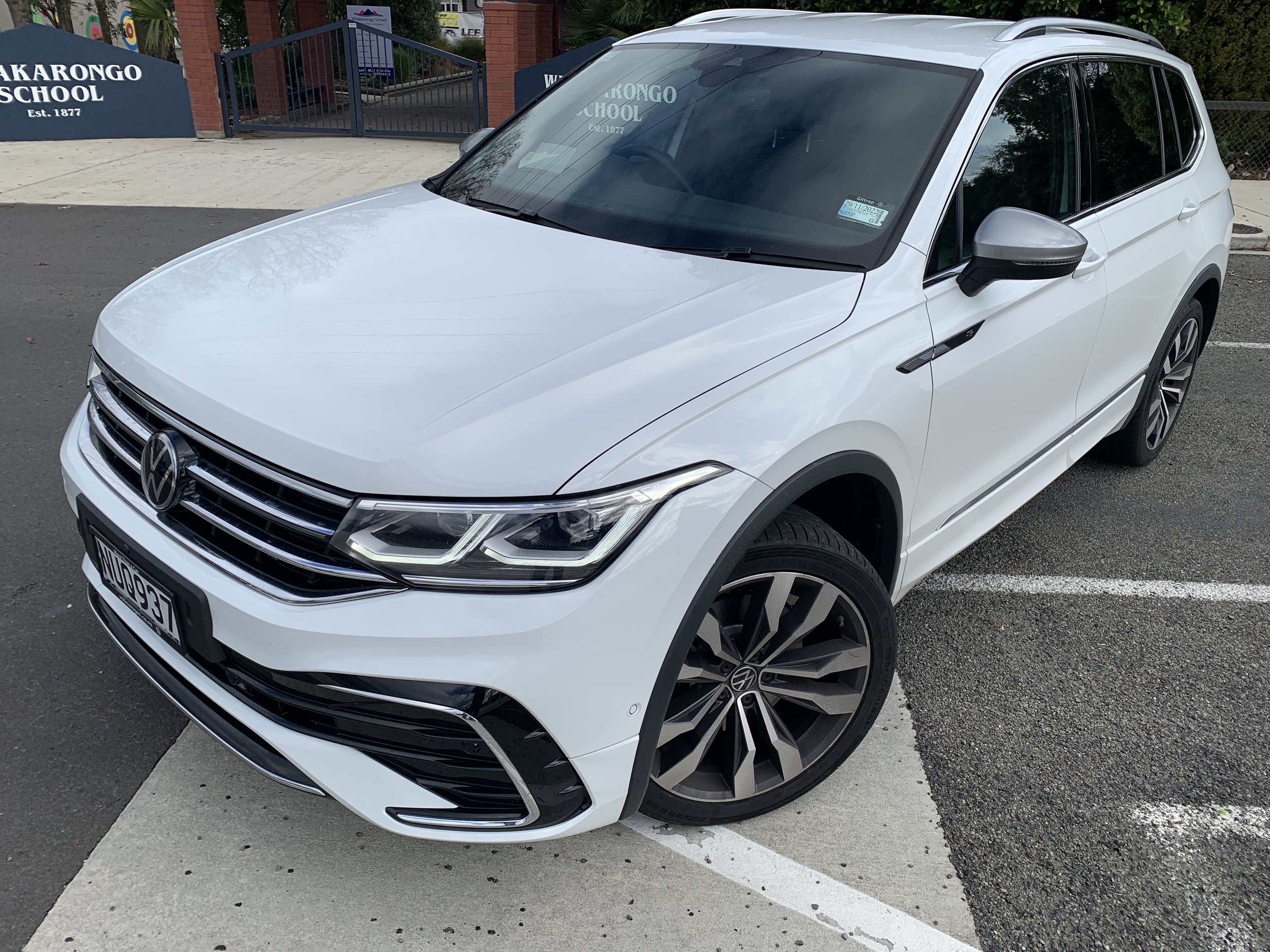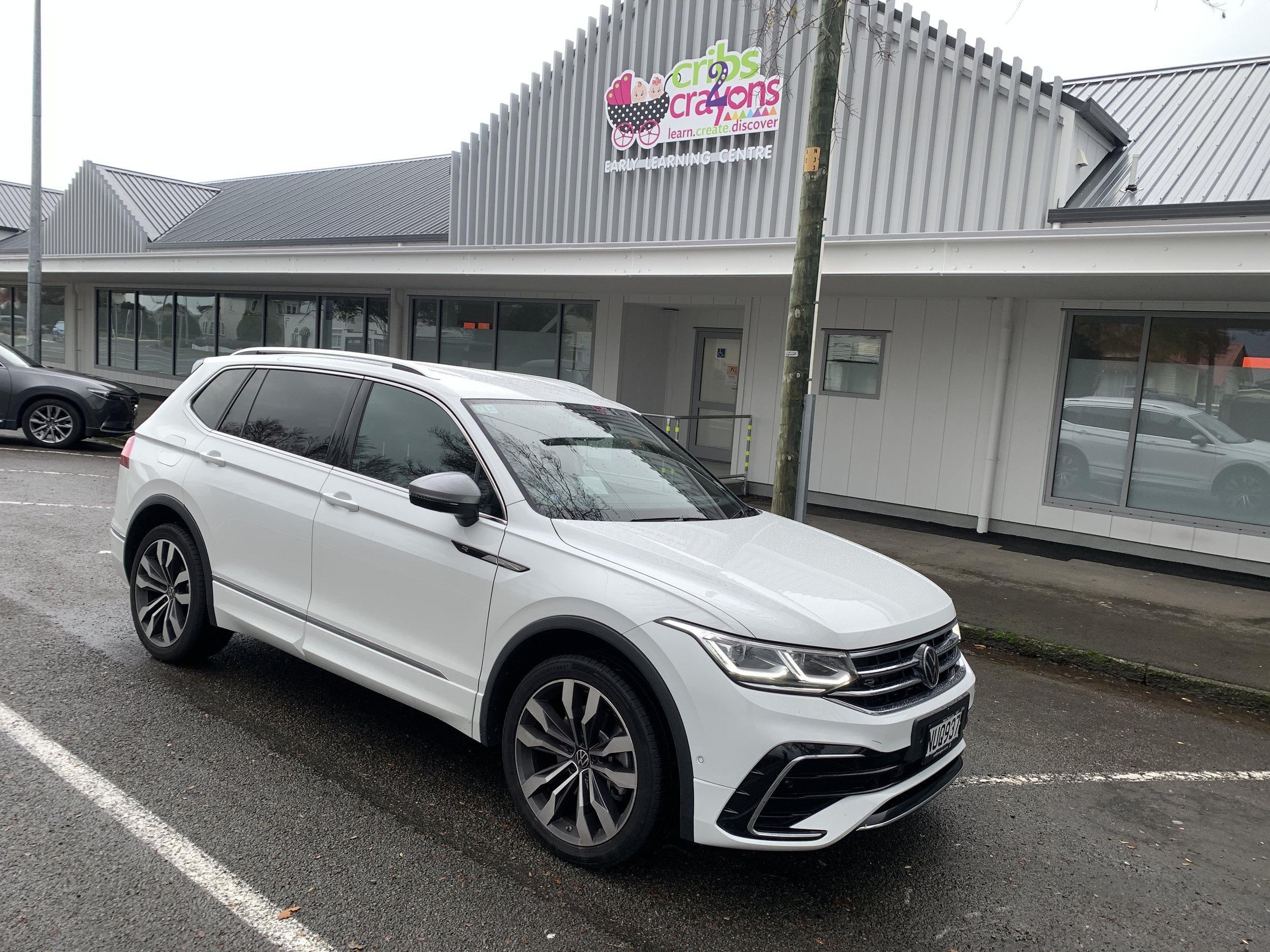Volkswagen Tiguan Allspace R-Line roadtest review: Going all the way
/All the positive traits of a five-seater model but with a bigger boot and two extra occasional chairs. But is the flagship too plush for school run punishment?
Price: $73,990.
Powertrain and economy: 2.0-litre petrol inline four, 162kW/350Nm, 7-speed twin clutch automatic, AWD, combined economy 9.4L/100km, CO2 214g/km ($1610 Clean Car fee).
Vital statistics: 4701mm long, 1839mm wide, 1665mm high, 2787mm wheelbase, luggage capacity 700-1755 litres, 20-inch alloy wheels.
We like: Decent practicality, well-sorted driving feel, handles more like a conventional hatchback than some rivals.
Not so much: A bit too premium than it possibly needs to be, lacks plug-in hybrid option, steering wheel touch controls too easy to activate accidentally.
NO ‘ifs’ about it; you need a lot of butts to get the best out of the biggest kind of Tiguan. Seven, really.
Patently, that’s a challenge Kiwis are keen to meet. The Tiguan has for some time now been the best-selling Volkswagen model nationally and the Allspace – the one that upgrades the seating plan from a regular five chairs over two rows to two extras over three – has proven so successful in exploiting those potentials it is now more popular than the ‘regular’ model.
Clearly, those who collated national statistics showing families are becoming more nuclear didn’t include Tiguan types in their analysis.
Seven seats, seven days. I’ll admit now that none gave opportunity for optimal utilisation. Team Bosselman comprises but two adults, so only the front row was guaranteed for bookings. Yes, we did try to invite others who normally would be willing involvers, but all plans fell through. Kidnapping was never contemplated. No A waste of space? Sure. But not, wholly, of core talent.
Many updates deliver for what some are calling this car’s mid-life rejuvenation. Which it probably really isn’t, as a whole new one is confirmed for 2024. The 2022 car identifies by having subtle revisions to the front end, with a new grille and slender headlights, while the taillights have been updated, too, with dark-red LEDs added. More significant changes occur inside, with improved equipment and the introduction of VW's latest infotainment systems.
Plus, there’s a rejig of the trim structure. The car as you see it on test is R-rated. Not in the fullest sense. At optimal, ‘R’ in VW-speak means hard-core performance porn. There is a Tiguan R, with the same rorty 2.0-litre EA888 powertrain as the Golf R. That’s not the car on test. The Allspace doesn’t go to that level but stops a little lower, at ‘R-Line’. That means it teases more than outright touches; there’s a bit of extra zap, a sportier body kit and 20-inch wheels. That’s probably quite enough, really, given it’s a model that puts family first.
If that extra prep seems a bit extravagant, there are other Allspace options. Just to remind the line-up starts at $49,990 for the ‘Life’, which runs a front-drive 110kW/250Nm 1.4 turbo and, with CO2 of 191g/km (equating to a claimed average of 8.5L/100km), is the only variant that’s cost-neutral under the Clean Car Discount.
If you want Allspace with all-wheel-drive and more oomph, then it’s a big leap to the $63,990 Style, with a 2.0-litre petrol that’s effectively the same as in the R-Line, but in a lower state of tune: You say goodbye to 30kW and 30Nm. The engine in its reduced state actually consumes slightly more (officially, it’s just 0.1 of a litre over 100km) petrol and outputs 2 grams per kilometre in CO2, so actually cops a slightly higher Clean Car fee than the R-Line. Diesel? It’s gone, sad to say.
Achieving the highest-performing version of the petrol engine is a good kerbside kudos on the school run, but realistically is a factor unlikely to singularly warrant spending the $10k premium the new trim pack carries. Neither will it being a better-looking product also simply make it simply worth all those extra bucks.
As much as panache might be an important consideration, it’s pretty obvious practicality also comes into this pitch. It’s really the bottom line. On those grounds, it’s only reasonable to say now that the Allspace has some pretty strong rivals.
Cars in this sector have all but replaced people carriers as transport for large families, but the amount of space you get can vary quite a bit. The Hyundai Santa Fe, Kia Sorento, Mercedes GLB, and Toyota Highlander might very likely sit on some comparison charts. If they do, you’ll notice some of those have the option of a plug-in hybrid drivetrain. An opportunity that will, one day, come to the Tiguan. But presently doesn’t.
However, it does come to another Volkswagen trawling the same beat. Even though it presents in a boxier format, is $6000 dearer in base format and lower-specced than the R-Line at that entry price, the VW Multivan with its e-hybrid drivetrain surely has to be considered as an alternate.
There are obvious benefits from taking a model that sits on a road car base and aims to bridge the gap between MPVs and van-based people carriers. While the petrol engine is smaller (a 1.4-litre) and everything delivers in front-drive, the combined petrol-electric oomph creates identical torque. The ace card is much lower fuel spend. The potential for much lower fuel economy still exists even after you’ve exhausted the up-to-50kms pure electric operability. And it’s roomier.
To be fair, the Allspace isn't billed as a full seven-seater. The concept is more about offering a ‘third row of fold-flat occasional seats’ and these are really intended to provide extra passenger capacity when needed. Fair to say the two extra seats are only suitable for children or small adults who are prepared to be uncomfortable on short journeys.
Regardless that, in respect to how much space it allocates, and where, even if the Allspace isn’t quite fully class-smashing, it is clever and competent. The 110mm VW has added to the wheelbase comfortably gives enough room to place pews in the boot in a safe manner; heads are not too close to the rear glass, for one.
But it’s not the largest of the seven seaters. The conjoined Koreans and the Highlander (which, just to remind, is made in, and primarily for, America) has more space, particularly across the cabin and with more room between the rows.
Even without any kids to try them out, the measurements suggest the rearmost seats are decent for smaller bodies, that area is more for occasional than full-blown daily use. The 60/40-split middle swat row will tilt, slide and fold out of the way if needs be. The more space given the rear-most passengers the less there will be further up the cabin.
As a tall person, I needed my chair back quite a way, and low too, but there was still decent foot and knee toom behind. In respect to the driving position, there’s plenty of adjustment in the seat and steering wheel.
VW’s idea is that you’re more going to be using the Allspace in five-seat mode, with those extra chairs in reserve for emergencies, seems sound. Regardless that even with all seven seats in place there’s still some space left behind them for shopping, if not a buggy, it works best as a five-plus-two, with it coming up trumps because the boot offers a generous 760 litres of space in this configuration.
It's worth noting that while the Allspace has five seats in the back, it's still just the outer two chairs in the middle row that are equipped with ISOFIX child-seat anchors.
The interior is typically VW in design, construction and feel. That means lots of soft-touch plastics and controls that feel solid and responsive. The R-Line’s reach toward premium-ness means it has ambient lighting that can be set into all manner of hues and also takes whoppingly decent audio system. It’s really too plush sticky-fingered, seatback-kicking, food-smearing raucous minions.
The car’s technical enhancement also elevates its ambience. The digital instrument display and touchscreen are smart touches that look as good here as in the donor Golf Mk 8, though maybe the touch-sensitive climate controls could prove controversial.
They’re fiddly to use while driving, with adjustments to the temperature requiring you to take your eyes off the road, unlike the knob-adjusted setup in the old car. Also, the pads are not illuminated at night, which seems like a oversight.
The touch sensitive pads that replace the usual buttons on the new steering wheel to control aspects of the infotainment system, digital dash and active cruise also require care; three times I managed to accidentally activate the steering wheel heating function.
An around-view camera, front and rear parking sensors and a parallel park assistant are all standard, the adaptive cruise now offers a degree of self-steering, for just a moment, and a lane keeping function that can be a pain on winding roads as it tries to readjust your cornering line. Night driving is enjoyable as it has impressive matrix headlights that let you keep high-beam on at all times, directing it away from other traffic.
The driving ‘feel’ side of things will clearly be impacted by how much load is on board, or even behind – this model having a towing capacity of 2500kg.
Refinement is very good. You will hear a flutter of wind noise around the door mirrors, but even with such big feet there’s low road noise. Indeed, those low-profile tyres don’t seem to remove much from the overall comfort and composure.
A maximum of two adults onboard perhaps flatters its abilities, but that’s what it had and, in that scenario, it was decent. The balanced suspension setup and light steering making it easy to place and manoeuvre on smaller roads. The R-Line’s adjustable suspension has modes to make the ride more comfortable or sporting. From my experience, you're likely to want to keep it in Comfort mode almost all of the time; this alleviates ride quality but doesn't sacrifice body control. Sports mode provides a 'sportier' feel, but it’s not necessarily a more enjoyable one. In Comfort mode the suspension has more yield, yet is still firm enough to stop the body bouncing up and down too much along undulating roads.
While the steering might not offer huge amounts of feedback to the driver you always feel assured on turn-in to a corner and it stops well, too. Through a challenging set of corners, when driven solo, the Allspace felt assured and stable, a benefit perhaps of it having fat rubber and also due to that longer wheelbase.
The engine is strong and smooth and interacts fairly well with the direct shift transmission; any perceived tardiness can be solved by a quick downshift on the paddles behind the wheel.
It’s a bit thirsty, though; even with just two onboard the economy was tipping into the 10 litres per 100km zone. I can imagine it’d burn more with extra bums in seats. Front-drive Tiguans are much more frugal, but you cannot get that with the R-Line. The all-wheel-drive is great for the image, and beneficial for driving, though it’s really just an on-road assist. As much as the Tiguan sets out to fulfil fully as a SUV, it’s hard to imagine it clambering around off-road.
All up, the Tiguan Allspace is a likeable and patently high-quality vehicle, just like the regular one. It looks more substantial and there's plenty of extra room in the boot, added to the versatility of the seven-seat option.
Relatively speaking, it's expensive to buy and I ‘d personally be reluctant to expose such a classy interior to prolonged abuse from small passengers.






















